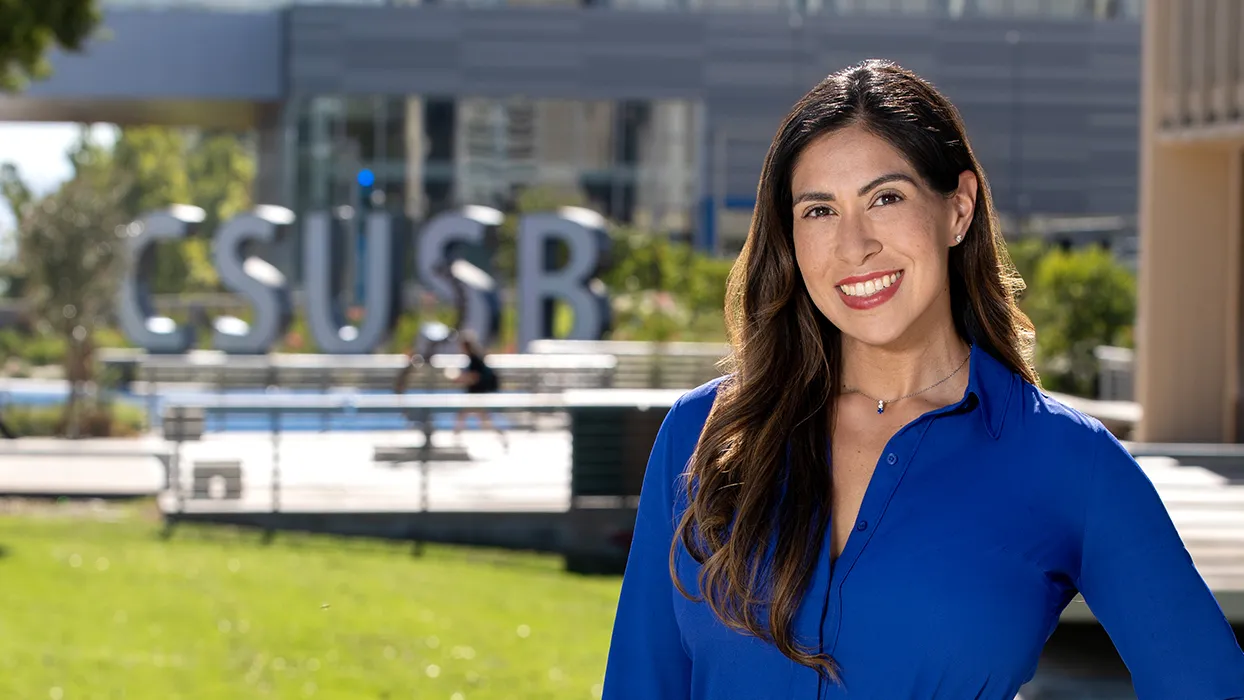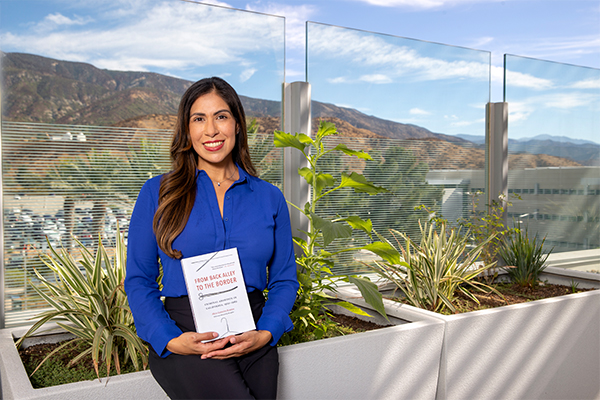Alan Llavore | Office of Marketing and Communications | (909) 537-5007 | allavore@csusb.edu

Alicia Gutierrez-Romine has a knack for discovering untold, and sometimes uncomfortable, stories of the past. Her work, which explores the history of abortion in the United States, has attracted national attention, particularly since the Supreme Court's 2022 decision to overturn Roe v. Wade.
Born and raised in the Inland Empire, Gutierrez-Romine, an associate professor of history at Cal State San Bernardino, grew up in Moreno Valley and is herself a CSUSB alumna. “I chose to go to CSU San Bernardino, truly, because it's where my brother went,” she said. “I was kind of familiar with the campus already. I feel for a lot of children, particularly of immigrant parents, you stick with what's familiar.”
Initially, she double-majored in business and history, reasoning that for “fun” she would study history, an interest nurtured by her father, and study business to prepare for a career as a restauranteur.
But after taking a business law class and realizing how vulnerable business owners are to lawsuits, she decided owning a business was not for her. Now, she said, "I joke around that I love my job because all I do is read books, tell stories and hang out with 20-year-olds all day, so it's not too shabby."
After earning her bachelor’s degrees in 2010, Gutierrez-Romine pursued her Ph.D. in history at the University of Southern California. The initial topic of her dissertation was an exploration of eugenics from the perspective of nonwhite physicians in Southern California during the pre-World War II era. But a limited window of time in her schedule and a misunderstanding changed the course of her research.
"I had neglected to get the required permission from the California State Archives to look at records from World War II onward," she said.
The oversight led to her discovery of what would become her major field of study.
"I basically said to the archivists, ‘Give me anything in this collection that is approved that I can look at.’ By the end of the first day, I had discovered an illegal abortion racket that was operating out of Los Angeles during the Great Depression,” she said. “They were making the modern-day equivalent of millions of dollars per month just performing illegal operations."
The Pacific Coast Abortion Ring, as it was called, extended as far north as Seattle and as far south as San Diego.
“When I found out that they were headquartered in Los Angeles, I immediately reached out to one of my dissertation advisors, who I consider the ‘god’ of L.A. history. If anything happened in L.A. history, he knows,” she said. She dashed off an email and didn’t have to wait long for his response. “I’ve never heard of this before,” his email read. “You need to find out everything you can.”
This accidental discovery became the topic of Gutierrez-Romine’s dissertation and later her critically acclaimed book, published in 2020, “From Back Alley to the Border: Criminal Abortion in California, 1920-1969,” which examines the history of criminal abortion and abortion legislation in California before Roe v. Wade.

Prior to the mid-1930s, Gutierrez-Romine said California's abortion laws allowed licensed medical professionals to perform the procedure, if necessary, effectively exempting them from criminal penalties. “It gave legitimate medical professionals essentially carte blanche to perform these procedures,” she said. However, in 1935, the law was tightened to criminalize all abortions unless performed to save a woman's life. This change coincided with the rise of the Pacific Coast Abortion Ring between 1935 and 1937.
“The law morphed from being something about consumers, consumer protection and patient protection to more of a focus on criminalizing the procedure when it was not performed to save a woman's life.”
Gutierrez-Romine noted that medical providers in the Pacific Coast Abortion Ring “were highly trained and competent, mostly medical professionals. There were some people who did not have medical licenses, but they were trained in this procedure, and they performed the procedure well. I found no evidence of any fatality among the Pacific Coast Abortion Ring doctors.
“So, they do stand in stark contrast to what is a typical understanding or mental image that most people have about what an illegal abortionist is. These were people who knew what they were doing was illegal, so they tried to do it as safely and effectively and as hygienically as possible because they wanted to stay under the radar,” she said.
Gutierrez-Romine referred to the ring as creating a “‘McDonaldization’ of medical providing, in a sense, because everything was sterile, hygienic. There were multiple offices and 32 providers of illegal abortions working for the ring in California, Washington and Oregon. Every office had the exact same layout, so that if the doctors needed to be shuttled or moved around, they could go right to work. Everyone knew the same thing was going to be in every drawer, regardless of what clinic they went to, so that no time was lost, they would not be inefficient.”
Gutierrez-Romine's work has had a significant impact beyond academia. Her research played a crucial role in California Gov. Gavin Newsom’s decision in 2022 to posthumously pardon Laura Miner, who escaped conviction related to her role in the Pacific Coast Abortion Ring, but was later convicted of performing illegal abortions in her own San Diego clinic in the 1940s.
Gutierrez-Romine’s contributions have also made her a sought-after expert on the history of abortion in the United States. She has been featured in major publications, including The Los Angeles Times, The Economist and The New Yorker, and has appeared on C-SPAN and the Discovery Channel. Since the Supreme Court’s decision to overturn Roe v. Wade in 2022, she sees parallels between the pre-Roe era and the possible consequences of current abortion restrictions.
"Criminalizing abortion doesn't stop abortion. It creates opportunities and pathways for illegal providers, but it also creates unsafe conditions for women who are trying to seek these medical procedures," she said. Her research highlights the dangers of restrictive abortion laws and the bureaucratic complications they introduce, which often put women’s health at risk.
"If we try to create a law that leaves these little exclusions, it's just perpetuating this really gray area that we don't know how to work with. And that's ultimately where women fall at risk."
Her recent book, “Roe v. Wade: Fifty Years Later,” published by the University of Georgia Press, continues this exploration of reproductive justice in a post-Dobbs world. The book, co-edited with other scholars, reflects on the centuries-long history of abortion, its legal and cultural representations, and the ongoing struggles for reproductive freedom.
As she begins her second year as a faculty member at CSUSB, she continues to explore history and its impact on the present. Her current research focuses on race, immigration and public health in California from the 1850 cholera epidemic to the construction of border inspection sites in 1933. This work, she hopes, will shed light on how public health has been racialized and the implications of these historical processes on contemporary issues.
“It's important for us to find these stories that sometimes make us uncomfortable to be able to see, what can we learn from that today,” she said. “What can we fix? Because those things are still in our power. Even if this is something that has happened in the past.”